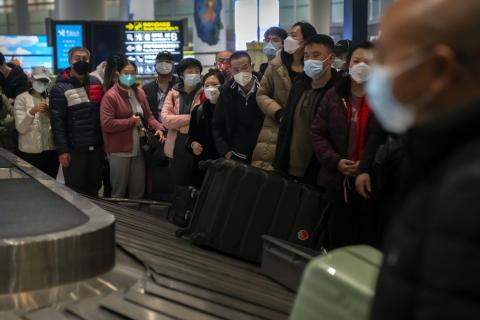
People over 60 or with health issues should wear a medical-grade mask when they are out and cannot socially distance, according to new guidance from the World Health Organization, while all others should wear a three-layer fabric mask.
The announcement on Friday marks a significant change of stance by the WHO, which until now has been reluctant to advocate the wearing of masks by the public because of limited evidence that they offer protection.
The health body’s new guidance document says the over-60s and people with underlying health conditions should wear medical masks in “settings where physical distancing cannot be achieved” because of “increased risk of infection and/or negative outcomes”.
All others should wear a three-layer fabric mask: absorbent cotton closest to the face, followed by a polypropylene layer and then a synthetic layer that is fluid-resistant, the WHO said. It envisages that these masks can be made at home, but that small companies may begin to produce them, also providing jobs.
The WHO said people should be advised to wear masks not only on buses and trains but also wherever physical distancing may be hard - in grocery stores, at work, at social gatherings, at mass gatherings and in closed settings, including schools, churches, mosques and other places of worship.
Until now the global body has been reluctant to advocate the wearing of face coverings by the public because of limited evidence that they offer protection. There were also fears of a rush on masks leading to shortages of medical-grade versions for health workers.
The new guidance follows research commissioned by the organisation into what sort of mask could protect people in the community. It is still unknown whether the wearers are protected, say its experts, but the new design it advocates does give protection to other people if properly used.
Masks are no substitute for physical distancing and hand hygiene, it was emphasised.
Dr Maria Van Kerkhove, technical lead of Covid-19 response and the head of emerging diseases and zoonosis unit at WHO, expressed concerns about masks offering a false sense of security at protests, such as those taking place over the killing of George Floyd in the US. “There are many gatherings taking place across the globe for different reasons. People who put a homemade mask on feel a sense of protection. It is a false sense of protection,” she said.
“Masks must be part of a comprehensive strategy. They do not work alone. They must be used with a number of measures. I want to stress that anyone who is unwell should be at home. They should be tested, their contact should be identified and they should be in quarantine.”
When people are out, she said, “physical distancing of at least 1 metre provides protection against transmission. The further the distance, the better, but at least 1 metre.”
The WHO director general, Dr Tedros Adhanom Ghebreyesus, said the body’s position that masks alone would not protect people remained the same. But, he said, “in the light of evolving evidence, WHO advises that governments should encourage the general public to wear masks where there is widespread transmission and physical distancing is difficult, such as on public transport, in shops or in either confined or crowded environments”.
The guidance includes not only the three types of fabric that masks should be made from, but also washing instructions, he said. “People can potentially infect themselves if they use contaminated hands to adjust a mask or to repeatedly take it off and put it on, without cleaning hands in between.”
People caring for somebody who is sick at home should wear a medical mask, not a fabric mask, WHO advises. “WHO continues to advise that people caring for an infected person at home should wear a medical mask while they are in the same room as a sick person,” said Tedros.












